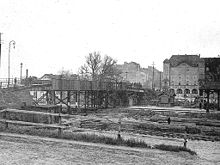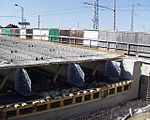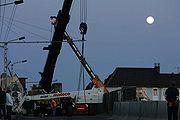Eberswalde station bridge
The Eberswalde station bridge (also known as the "railway bridge") is the only crossing-free crossing of the Berlin – Szczecin railway line in the district town of Eberswalde .
landmark of the city
Neither architecturally nor technically this structure was anything special. It was a riveted double truss arch bridge . For the people of Eberswalde it was still the symbol of the city because it shaped the cityscape and you had to pass it when crossing the city. This is also evident from the fact that it is used on the "Barni thalers".
The old structure is generally regarded as the station bridge or railway bridge. This bridge was demolished and rebuilt in 2004. The prestressed concrete bridge, which was built to relieve the old bridge, was also dismantled. The new four-lane bridge removed the bottleneck for east-west traffic.
history
In 1842, only seven years after the first German railway line Nuremberg – Fürth , Eberswalde was one of the first cities in Germany to be connected to the railway network. At that time, the station was still relatively far outside the city. This was a demand of the Eberswalde city fathers, which almost led to the long-distance railway line being planned far past the city. It soon became clear that the expansion of the railway road to supply the city was important. As a result, the city grew mainly to the west, i.e. towards the train station. The first wooden bridge was built over the tracks as early as 1867. Due to the construction of the Westend district, the station bridge was built in 1908 to replace a wooden bridge from 1904. After the trolleybus started operating for a few months in 1901 , the electric tram ran from 1910 to 1940 .
The bridge was only slightly damaged in World War II .
Parts of the bridge had to be renewed as early as the mid-1950s. The rust had damaged large parts of the structure. The old road substructure of hump plates was replaced, new longitudinal and transverse support installed and in-situ concrete -Fahrbahn made. The walkway on the building was widened.
In the 1980s, the electrification of the railway line made it necessary to raise the bridge. This project would have resulted in the F 167 being closed for more than six months. All traffic should be diverted via Britz . Investigations had shown that the barriers in Forsthaus and Britz were closed for more than twelve hours a day, so that vehicle traffic would have been constantly jammed on the diversion route. Therefore it was decided to build a new bridge next to the existing structure. This structure is a prefabricated bridge made of BT 700 girders. The Eberswalde bus station was also built as part of the construction work. After the new bridge was released, the old truss bridge was raised. At the same time, a section of the fore bridge was replaced by a BT-700 superstructure.
demolition
The demolition work on the bridge began on October 4, 2004, and the first arch elements were dismantled on October 30, 2004 in front of several hundred spectators. On January 21, 2005, the bridge was completely demolished.
New building
After erecting the bridge abutments and new pillars in monolithic reinforced concrete construction, a total of twelve steel-concrete composite elements were lifted onto the new substructures on April 23 and 24, 2005. The composite elements are technically not new, but still relatively little widespread. They are characterized by their very light construction and high load capacity. There is a thin concrete slab on the vertical steel girders, which already contains anchors for the later reinforced in-situ concrete ceiling.
The steel girders were manufactured in Niesky and then transported to the concrete plant in Vilshofen . The in-situ concrete flange was produced here. Then the elements were driven to Eberswalde. The elements were approximately 2.80 meters wide, 35 meters long and had a mass of 40 tons. The bridge achieved its full load-bearing capacity thanks to an in-situ concrete supplement that was approximately 20 centimeters thick and concreted in one piece. The bridge's “fixed camp” is located on the western pillar of the bridge. Both abutments and the eastern pillar received movable bearings. In order to compensate for the movements of the bridge due to braking, starting and temperature, for example, lane crossings were arranged on both abutments. The western abutment received a single carriageway crossing, on the eastern side a double crossing with maintenance walkway was built.
On October 4, 2006, the new station bridge was completed and opened for public transport by the Brandenburg State Secretary for Infrastructure, Reinhold Dellmann. The new construction was carried out as a three-span bridge in steel composite construction. The total span has a length of 95.5 meters, the useful width is 23.2 meters. The construction is equipped with sidewalks and cycle paths, guide strips for the blind, street lighting and overhead lines for the trolleybus . The bridge spans ten Deutsche Bahn tracks .
Web links
Coordinates: 52 ° 50 ′ 4 " N , 13 ° 47 ′ 53" E










